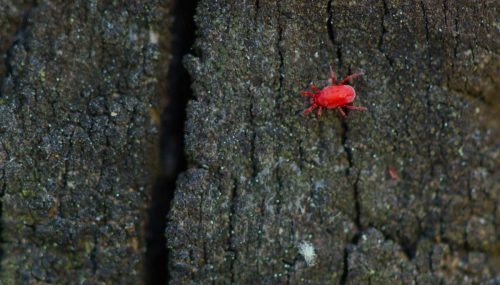How to Get Rid of Clover Mites

Pest infestations are one of those things you never think about until the moment you notice them. One day, you’re worried about doing your typical household chores; the next, your every waking thought is occupied by how to eliminate whichever creature has invaded your personal space. Clover mites are one such bug you might spot as the seasons turn or when there’s a dramatic shift in weather. Here, professional pest control experts share more about what causes them, how to get rid of clover mites, and easy ways to ensure they never come back.
RELATED: How to Get Rid of Cockroaches.
What Are Clover Mites?

Clover mites are small arachnids that are members of the mite family. They feed on and typically live on plants but will sometimes make their way indoors, especially after heavy rain or long dry spells.
“They are visible to the naked eye and are a reddish or reddish-brownish color,” says Megan Wede, co-owner of Done Right Pest Solutions.
However, you needn’t be too alarmed if you spot them in your home. “I wouldn’t consider clover mites harmful, as they will die off without being close to plants due to unfavorable conditions,” says Wede. “They do not bite—they are just annoying!”
Although they feed off vegetation, they don’t pose a serious threat to plants either. (But it’s worth noting that a large infestation could cause aesthetic changes to plants by giving them red splotches or silver streaks.) They’re particularly drawn to heavily fertilized lawns and ornamental grasses.
What Are the Signs of a Clover Mite Infestation?

The most common times of year to spot clover mites indoors is spring and fall.
The biggest sign is that you’ll see them—sometimes in the hundreds to thousands. While that could be shocking, they won’t stick around long. “Typically, they will die off within a couple of days or a week or so,” says Wede.
“They commonly appear in bathrooms, although they can enter anywhere in a structure due to their small size,” says Scot Hodges, entomologist and vice president at Arrow Exterminators. “You may also observe them crawling around on exterior walls as they try to enter the structure.”
If you don’t see the bugs when they are alive, you may see the red stains they leave behind.
RELATED: How to Get Rid of Ants in the Kitchen.
How to Get Rid of Clover Mites

Reduce vegetation around your home.
This removes the clover mites’ food source, so they’ll look for nourishment elsewhere. “Focusing on the outside areas adjacent to any rooms where they are found will provide the best results,” says Hodges. “Clover mites will continue to thrive in those environments unless the conditions are changed.”
In many cases, they’ll return to the same spots year after year, so pay special attention to those areas.
Vacuum the clover mites.
If the bugs make it into your space, you can vacuum them up. “Be sure to empty or throw away the vacuum bag afterward in an outdoor receptacle,” says Hodges.
Use a spray made of water, dish soap, and white vinegar.
Mix the three ingredients together and spritz the bugs (Wede uses Dawn).
“This should kill most small insects like clover mites on contact,” she says. “Plus, it’s clean, so you can just wipe it up.” The solution is also safe for indoor and outdoor plants that have been afflicted.
How a Professional Will Treat Clover Mites

Although clover mite infestations typically don’t last very long, you might not want to put up with them even as temporary visitors. In that case, call in a pro.
“As with any pest management service, the first step is to inspect and identify the pest, and once the identification is confirmed, determining the source is the next step,” says Hodges.
The professional may suggest some measures, like removing or reducing the number of plants in certain problem areas outside of your home. They may also apply residual material outside since that’s where infestations begin.
“The exterior treatment would focus on the perimeter of the structure and would likely include an application to the soil and vegetation adjacent to it, extending out three to six feet,” says Hodges. “An application to the foundation may also be helpful if they are actively crawling on the structure.”
You likely won’t need anything done inside. “Clover mites will not reproduce indoors; they have about a two-week life span and will likely die within a couple of days of entering the structure due to dehydration,” says Hodges.
RELATED: 4 Soaps and Scents That Repel Mosquitoes, Experts Say.
How to Prevent Clover Mites from Coming Back
To prevent the clover mites from returning, focus your efforts on the place where the last infestation occurred. Minimize the amount of vegetation in those spots; if the infestation is severe, Hodges suggests considering a one- to two-foot vegetation-free zone next to the home.
If the clover mites keep finding their way into your home year after year, go one step further than a pest control expert.
“Consulting with a lawn professional may be necessary,” suggests Hodges. They’ll be able to help you make landscaping choices that improve your chances of success.